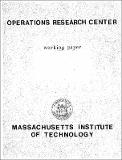| dc.contributor.author | Chaiken, Jan M. | en_US |
| dc.contributor.author | Larson, Richard C., 1943- | en_US |
| dc.date.accessioned | 2004-05-28T19:34:26Z | |
| dc.date.available | 2004-05-28T19:34:26Z | |
| dc.date.issued | 1971-06 | en_US |
| dc.identifier.uri | http://hdl.handle.net/1721.1/5337 | |
| dc.description.abstract | An urban emergency service system provides mobile units (vehicles) to respond to requests for service which can occur at any time and any place throughout a city. This paper surveys recent quantitative work aimed at improving the allocation policies of these systems, including determining the number of units on duty, designing response areas and patrol patterns, and locating service facilities. Recent models which provide insight into system operation are proposed to replace traditional rules-of-thumb as guides to allocation decision-making. The methods discussed are applicable to police and fire departments, emergency ambulance services, and certain other emergency service. | en_US |
| dc.description.sponsorship | U. S. Department of Housing and Urban Development under Grant H-1056 and in part by the National Science Foundation under Grants GK-16471 and GI-5. | en_US |
| dc.format.extent | 1746 bytes | |
| dc.format.extent | 3225169 bytes | |
| dc.format.mimetype | application/pdf | |
| dc.language.iso | en_US | en_US |
| dc.publisher | Massachusetts Institute of Technology, Operations Research Center | en_US |
| dc.relation.ispartofseries | Operations Research Center Working Paper;OR 003-71 | en_US |
| dc.title | Methods for Allocating Urban Emergency Units | en_US |
| dc.type | Working Paper | en_US |
